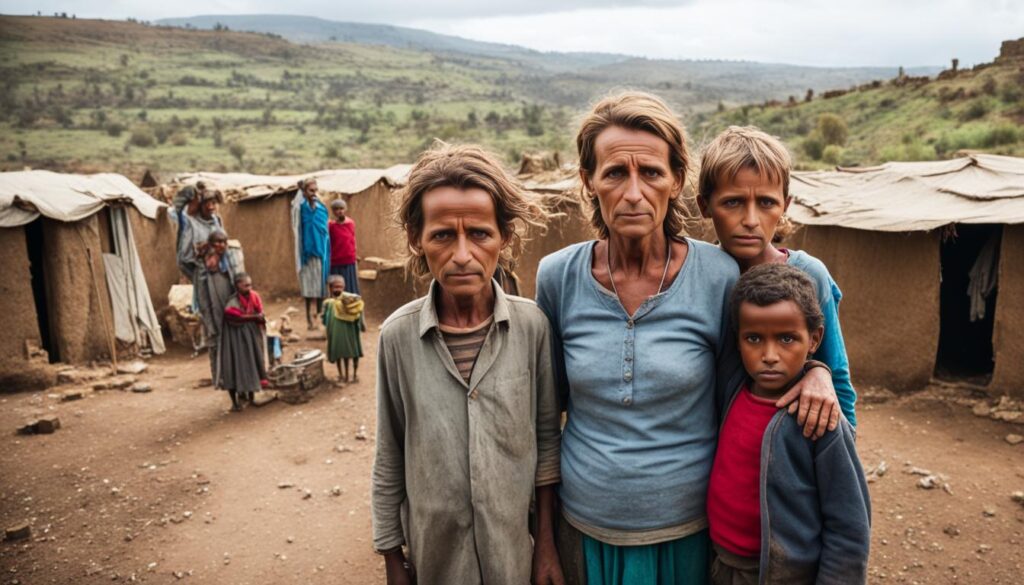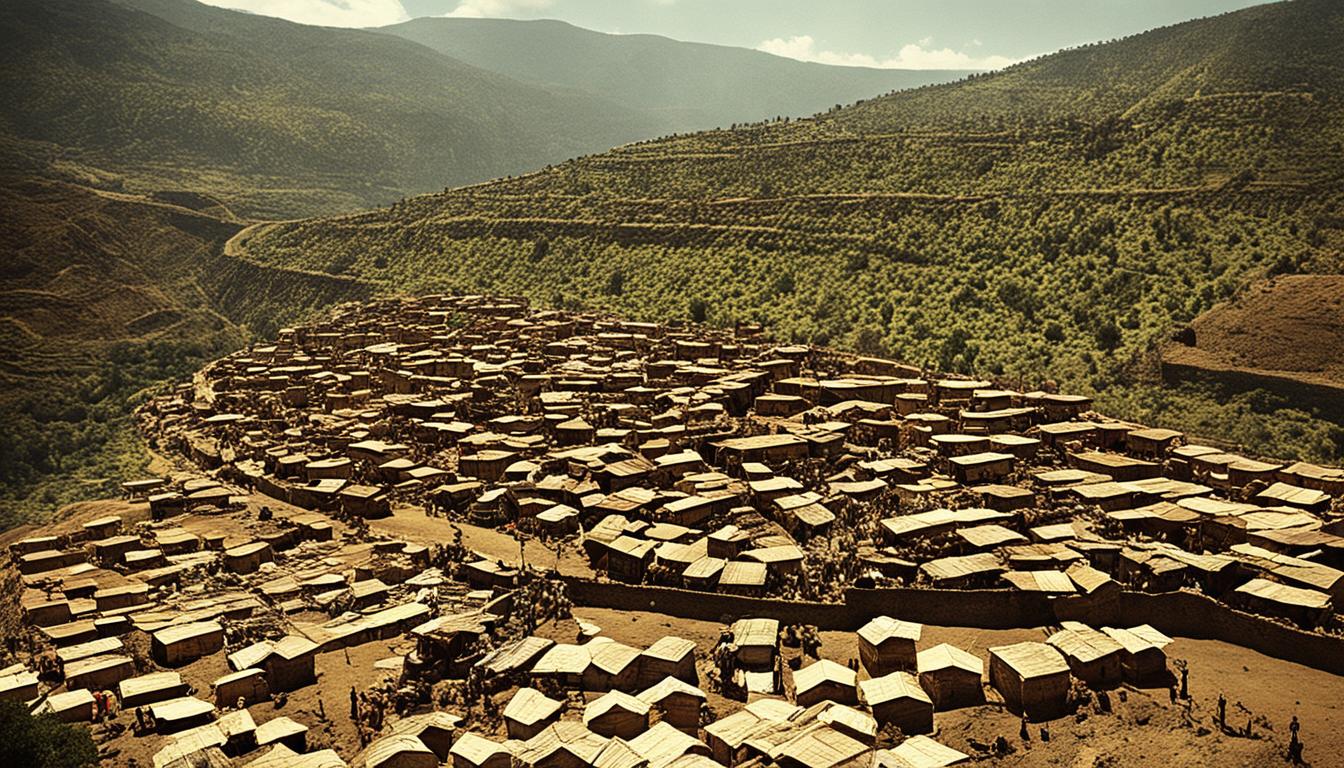Is Ethiopia Poor or Rich?
Did you know that Ethiopia has experienced significant economic growth over the past decade, despite being classified as one of the poorest countries in the world? This may come as a surprise, considering the prevailing perceptions of poverty and deprivation in the country. Let’s delve deeper into Ethiopia’s economic landscape to understand whether it is poor or rich and the factors that contribute to its unique situation.
Key Takeaways:
- Ethiopia has experienced impressive economic growth, with a GDP growth rate of 8% to 11% annually.
- The country has made progress in poverty reduction and achieving sustainable development goals.
- Income inequality in Ethiopia is relatively low compared to other countries.
- Foreign direct investment has played a crucial role in Ethiopia’s economic development.
- Diversification of exports and infrastructure development are key areas of focus for Ethiopia.
Ethiopia’s Economic Growth and Development Index
Despite its challenges, Ethiopia has experienced significant economic growth over the past decade. From 2000 to 2016, the country’s GDP grew at an impressive rate of 8% to 11% annually, fueled by government investments in infrastructure and progress in the agricultural and service sectors.
Ethiopia also boasts one of the lowest levels of income inequality in the world, comparable to Scandinavian countries. This achievement reflects the government’s commitment to inclusive growth and reducing disparities among its population.
The country’s development index has witnessed significant improvement, driven by poverty reduction, increased life expectancy, and progress towards achieving the Millennium Development Goals. As Ethiopia continues to prioritize sustainable development, it is essential to focus on key indicators and policies that promote economic stability and equitable growth.
Key Indicators
Ethiopia’s economic growth can be attributed to several key indicators:
- GDP Growth: From 2000 to 2016, Ethiopia’s GDP grew at an annual rate of 8% to 11%, surpassing the average growth rate for sub-Saharan Africa.
- Investment in Infrastructure: The government has made substantial investments in infrastructure, including roads, railways, and power generation, to support economic activities across the country.
- Agricultural Transformation: The agricultural sector has seen significant improvements, with increased productivity and adoption of modern farming techniques.
- Service Sector Expansion: The service sector has emerged as a key contributor to economic growth, particularly in areas such as telecommunications, banking, and tourism.
Economic Outlook
Ethiopia’s economic growth trajectory is expected to continue in the coming years, with the government implementing various strategies to drive further development. These strategies include:
- Industrialization: Ethiopia aims to transform into a manufacturing hub, with a focus on sectors such as textiles, garments, and agro-processing.
- Export Diversification: The country is working towards expanding its export base beyond traditional commodities like coffee, with a focus on gold, sesame, khat, livestock, and horticulture products.
- Foreign Investment: Ethiopia has attracted significant foreign direct investment, particularly from countries like China, Turkey, India, and the EU, which further boosts economic growth and job creation.
- Infrastructure Development: The government is heavily investing in infrastructure projects to address gaps and connect various regions within the country, facilitating trade and improving the overall business environment.
| Year | GDP Growth Rate |
|---|---|
| 2000 | 8% |
| 2005 | 9.8% |
| 2010 | 10.4% |
| 2015 | 10.2% |
| 2016 | 11% |
Poverty and Income Inequality in Ethiopia

Despite the progress made in poverty reduction, Ethiopia remains one of the poorest countries in the world due to rapid population growth and a low starting base. The poverty rate stands at 29.6%, which poses challenges to sustainable development.
However, income inequality in Ethiopia is comparatively low, with a Gini coefficient similar to that of Scandinavian countries. Efforts have been made to address income disparities through pro-poor spending on basic services and rural safety nets.
“Income inequality in Ethiopia is comparatively low, with a Gini coefficient similar to that of Scandinavian countries.”
While the poverty rate in Ethiopia remains high, it is important to note that income inequality is relatively low. This indicates a more equitable distribution of wealth compared to countries with similar levels of economic development.
The government of Ethiopia has recognized the importance of addressing income disparities in order to achieve sustainable development. Pro-poor spending on basic services such as education, healthcare, and social safety nets has been implemented to help lift the most vulnerable populations out of poverty.
Efforts to Reduce Poverty
Ethiopia has implemented various programs and policies aimed at reducing poverty and improving the well-being of its citizens. These include:
- Investments in education to improve human capital development and break the cycle of poverty.
- Expansion of healthcare services and increased access to affordable healthcare.
- Implementation of rural development programs to improve agricultural productivity and income for rural communities.
- Provision of social safety nets, such as cash transfers and food assistance, to support the most vulnerable populations.
Efforts to reduce poverty in Ethiopia have yielded positive results, with improvements in key social indicators and a reduction in the prevalence of extreme poverty. However, sustained efforts are required to address the root causes of poverty and achieve inclusive and sustainable economic growth.
| Country | Gini Coefficient |
|---|---|
| Ethiopia | 0.35 |
| Sweden | 0.25 |
| Denmark | 0.27 |
| Norway | 0.28 |
The table above compares Ethiopia’s Gini coefficient, a measure of income inequality, with those of selected Scandinavian countries. Despite its high poverty rate, Ethiopia’s relatively low Gini coefficient suggests a more equal distribution of wealth among its population.
Ethiopia’s Economic Indicators and Foreign Investment

When examining Ethiopia’s economy, it is important to note the significant influence of the state. Key sectors such as telecommunications, banking, and power distribution are state-owned, allowing the government to shape the economic landscape to a great extent.
In addition to state influence, Ethiopia has also attracted substantial foreign direct investment (FDI), amounting to approximately $8.5 billion. The majority of this investment comes from countries such as China, Turkey, India, and the European Union, indicating the international interest in Ethiopia’s economic potential.
To further support economic development, the Ethiopian government has implemented measures to promote industrialization in textile, garment, and agricultural sectors. These initiatives aim to stimulate growth, create employment opportunities, and enhance the country’s export capacity.
In an effort to boost exports and mitigate foreign currency shortages, the government devalued the Ethiopian birr by 15% in 2017. This move aimed to make Ethiopian goods more competitive in the global market and attract foreign buyers.
In summary, Ethiopia’s economic indicators demonstrate a unique blend of state influence, foreign investment, and government initiatives to drive growth and development in key sectors.
Ethiopia’s Foreign Direct Investment (FDI) by Country
| Country | Amount (USD) |
|---|---|
| China | 3.2 billion |
| Turkey | 1.5 billion |
| India | 1.3 billion |
| European Union (EU) | 1.2 billion |
Ethiopia’s Key Industries and Export Diversification
When it comes to Ethiopia’s economy, the country boasts a diverse range of major industries. These industries play a crucial role in driving economic growth, contributing to the country’s GDP and wealth distribution.
Some of the prominent industries in Ethiopia include:
- Food processing
- Beverages
- Textiles
- Leather
- Garments
- Chemicals
- Metals processing
- Cement
The country has also been making significant strides in export diversification. While coffee remains one of Ethiopia’s notable exports, the country has been expanding its export portfolio beyond this traditional commodity. Ethiopia now exports a variety of products, including:
- Gold
- Sesame
- Khat
- Livestock
- Horticulture products
The government’s efforts to diversify exports and expand international presence have resulted in a positive impact on the economy. Manufacturing exports are expected to grow, further boosting Ethiopia’s GDP and wealth distribution.
The services sector, led by the state-run Ethiopian Airlines, also plays a significant role in generating foreign exchange earnings for the country. The airline has established itself as a prominent player in the global aviation industry, contributing to Ethiopia’s economic growth.
Ethiopia’s Key Industries and Export Diversification
| Industry | Contribution to GDP |
|---|---|
| Food processing | XX% |
| Beverages | XX% |
| Textiles | XX% |
| Leather | XX% |
| Garments | XX% |
| Chemicals | XX% |
| Metals processing | XX% |
| Cement | XX% |
Ethiopia’s Economic Challenges and Infrastructure Development
Ethiopia’s remarkable economic growth and development index have not come without challenges. The country faces several infrastructural obstacles that hinder its progress in terms of power production and distribution, transportation, and urban planning. To overcome these hurdles, the Ethiopian government is actively involved in various infrastructure projects, including the construction of roads, railways, airports, and industrial parks.
One of the significant initiatives taken by the government is to enhance power generation capacity by building major dams and expanding into renewable energy sources. This investment in the energy sector will not only address the current power shortages but also drive sustainable economic growth in the long run. By harnessing Ethiopia’s vast renewable energy potential, we can promote eco-friendly practices and contribute to a greener future.
The Importance of Infrastructure Investments
Infrastructure investments play a vital role in supporting industrialization and bolstering the Ethiopian economy. By improving transportation networks and logistics, we can facilitate efficient trade and connectivity within the country and with the international community. Additionally, investing in urban planning will drive the growth of vibrant cities that attract businesses and foster innovation.
Infrastructure investments are not only crucial for economic growth but also for enhancing the overall quality of life for the Ethiopian people. They pave the way for better access to education, healthcare, and other essential services, ensuring that no one is left behind in our journey towards progress.
The Path to Sustainable Development
In order to achieve sustainable development, it is imperative that we continue to invest in robust infrastructure that supports economic growth, social progress, and environmental sustainability. Through strategic planning, collaboration, and innovation, we can overcome Ethiopia’s infrastructural challenges and lay a solid foundation for a prosperous future.
| Infrastructure Challenges | Government Initiatives |
|---|---|
| Power production and distribution | Building major dams and expanding into renewable energy sources |
| Transportation | Constructing roads, railways, and airports |
| Urban planning | Developing robust industrial parks and implementing sustainable urban development strategies |
With sustained efforts in infrastructure development, Ethiopia can overcome its challenges and pave the way for a prosperous and inclusive future.
Ethiopia’s Social Progress and Well-being
Despite the challenges, Ethiopia has made remarkable progress in improving the well-being of its population. The country’s commitment to development has yielded positive outcomes in various areas, contributing to a better quality of life for its people.
Advancements in Health and Education
One significant achievement is the increase in life expectancy, reflecting improved healthcare services and infrastructure. With a focus on maternal and child health, Ethiopia has made significant progress in achieving the Millennium Development Goals, as seen in the rise of antenatal check-ups and the decrease in fertility rates and infant mortality rates.
Educational opportunities have also expanded, ensuring greater access to quality education across the country. Efforts to reduce the population without education have been successful, providing more children with the opportunity to thrive and discover their full potential.
Addressing Poverty and Malnutrition
Ethiopia has made substantial strides in tackling poverty and reducing the prevalence of malnutrition. Stunting rates among children have significantly decreased, reflecting improved nutrition and healthcare. Efforts to address undernourishment have been successful, ensuring that more individuals have access to nutritious food and a healthier lifestyle.
Improved Living Standards
Access to improved living standards has seen a remarkable improvement, with significant advancements in providing electricity and piped water to households. The availability of these essential services has doubled, allowing individuals and communities to benefit from a more comfortable and sustainable living environment.
“Ethiopia’s focus on social progress and well-being is transforming lives and paving the way for a brighter future for its people.” – Ethiopia Development Agency
Ethiopia’s commitment to social progress and well-being is evident in the country’s remarkable achievements in various indicators. As the nation continues to prioritize inclusive and sustainable development, the positive impact on its population is undeniable.
Summary of Ethiopia’s Social Progress and Well-being
| Indicators | Progress |
|---|---|
| Increased life expectancy | Improved access to healthcare and infrastructure |
| Progress towards achieving the Millennium Development Goals | Enhanced maternal and child health services |
| Higher antenatal check-ups | Strong focus on improving pre-natal care |
| Decreased fertility rates | Successful implementation of family planning initiatives |
| Reduced infant mortality rates | Improved healthcare for newborns and infants |
| Reduced prevalence of stunting and undernourishment | Efforts in improving nutrition and food security |
| Decreased population without education | Expanded access to quality education |
| Doubled access to electricity and piped water | Improved living standards and sustainable environment |
Conclusion
In conclusion, Ethiopia’s economic landscape is multifaceted, with both challenges and opportunities. The country has made significant progress in poverty reduction, economic growth, and social well-being, although it still faces development gaps. Through partnerships with international institutions like the World Bank Group, the Ethiopian government is actively investing in various sectors to foster inclusive and sustainable development.
As Ethiopia strives for economic transformation, addressing key issues such as poverty, income inequality, and infrastructure development is crucial. The government’s commitment to poverty reduction has led to remarkable improvements in the well-being of the population, with life expectancy increasing and key indicators such as antenatal check-ups and infant mortality rates improving.
With a diverse range of industries, including food processing, textiles, and chemicals, Ethiopia is working towards diversifying its exports and expanding its international presence. The country’s economic growth, driven by government investments in infrastructure and the agricultural and service sectors, has shown promising results.




